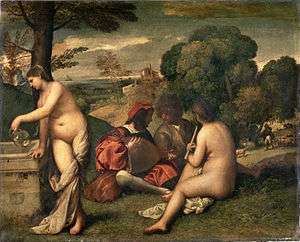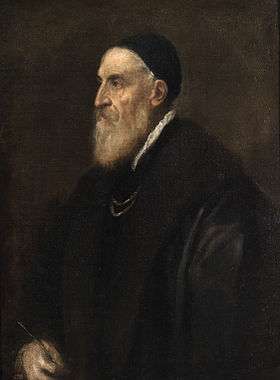Pastoral Concert
| French: Le Concert Champêtre | |
 | |
| Artist | Titian or Giorgione |
|---|---|
| Year | c. 1509[1] |
| Medium | Oil on canvas |
| Dimensions | 105 cm × 137 cm (41 in × 54 in) |
| Location | Musée du Louvre, Paris |
The Pastoral Concert, Fête champêtre or Le Concert champêtre is an oil painting of c. 1509 attributed to either of the Italian Renaissance masters, Titian (more usually today) or Giorgione. It is in the Musée du Louvre in Paris.
History
The painting was originally attributed to Giorgione, but modern critics assign it more likely to his pupil Titian, due to the figures' robustness which was typical of his style.[2] It is also likely that Giorgione (whose works included elements such as music, the pastoral idleness and simultaneous representation of the visible and invisible) began the work, and then, after his death in 1510, it was finished by Titian.[2]
The work was owned by the Gonzaga family, perhaps inherited from Isabella d'Este: it was later sold to Charles I of England. When the English royal collections were dispersed following,the revolution of 1649, the painting was sold at auction to the German banker and art collector, Eberhard Jabach, who, in turn, sold it to Louis XIV in 1671.[3]
The painting was also attributed to Palma the Elder and Sebastiano del Piombo.[4]
Édouard Manet conceived his Le déjeuner sur l'herbe (1863) after viewing the Pastoral Concert in a visit to the Louvre museum.[5]
Description
The painting portrays three young people on a lawn, playing with each other, while next to them a standing woman is pouring water from a marble basin (naked obviously). Both the women are naked, aside from two light vests; the two men are dressed in contemporary costumes. In the wide background is a shepherd and, among the vegetation, a far landscape.
The subject was perhaps the allegory of poetry and music: the two women would be an imaginary apparition representing the ideal beauty, stemming from the two men's fantasy and inspiration. The woman with the glass vase would be the muse of tragic poetry, while the other one would be that of the pastoral poetry. Of the two playing men, the one with the lute would represent the exalted lyric poetry, the other being an ordinary lyricist, according to the distinction made by Aristotle in his Poetics. Another interpretation suggests that the painting is an evocation of the four elements of the natural world (water, fire, earth and air) and their harmonic relationship.[5]
References
- ↑ "The Pastoral Concert". Department of Paintings: Italian painting. Musée du Louvre. Retrieved 28 November 2012.
- 1 2 Fregolent, Alessandra (2001). Giorgione. Milan: Electa. p. 111. ISBN 88-8310-184-7.
- ↑ "Le concert champêtre". Louvre Museum website. Retrieved 9 May 2011.
- ↑ Valcanover, Francesco (1969). L'opera completa di Tiziano. Milan: Rizzoli. p. 93.
- 1 2 Zuffi, Stefano (2008). Tiziano. Milan: Mondadori Arte. p. 32. ISBN 978-88-370-6436-5.
External links
- "The Pastoral Concert". Department of Paintings: Italian painting. Musée du Louvre.
